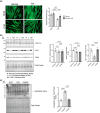Preventing loss of sirt1 lowers mitochondrial oxidative stress and preserves C2C12 myotube diameter in an in vitro model of cancer cachexia
- PMID: 38946587
- PMCID: PMC11215470
- DOI: 10.14814/phy2.16103
Preventing loss of sirt1 lowers mitochondrial oxidative stress and preserves C2C12 myotube diameter in an in vitro model of cancer cachexia
Abstract
Cancer cachexia is a multifactorial syndrome associated with advanced cancer that contributes to mortality. Cachexia is characterized by loss of body weight and muscle atrophy. Increased skeletal muscle mitochondrial reactive oxygen species (ROS) is a contributing factor to loss of muscle mass in cachectic patients. Mice inoculated with Lewis lung carcinoma (LLC) cells lose weight, muscle mass, and have lower muscle sirtuin-1 (sirt1) expression. Nicotinic acid (NA) is a precursor to nicotinamide dinucleotide (NAD+) which is exhausted in cachectic muscle and is a direct activator of sirt1. Mice lost body and muscle weight and exhibited reduced skeletal muscle sirt1 expression after inoculation with LLC cells. C2C12 myotubes treated with LLC-conditioned media (LCM) had lower myotube diameter. We treated C2C12 myotubes with LCM for 24 h with or without NA for 24 h. C2C12 myotubes treated with NA maintained myotube diameter, sirt1 expression, and had lower mitochondrial superoxide. We then used a sirt1-specific small molecule activator SRT1720 to increase sirt1 activity. C2C12 myotubes treated with SRT1720 maintained myotube diameter, prevented loss of sirt1 expression, and attenuated mitochondrial superoxide production. Our data provides evidence that NA may be beneficial in combating cancer cachexia by maintaining sirt1 expression and decreasing mitochondrial superoxide production.
Keywords: cancer cachexia; mitochondria; nicotinic acid; oxidative stress; sirtuin‐1.
© 2024 The Author(s). Physiological Reports published by Wiley Periodicals LLC on behalf of The Physiological Society and the American Physiological Society.
Conflict of interest statement
Authors have no conflict of interest to declare.
Figures




Similar articles
-
Valproic acid attenuates skeletal muscle wasting by inhibiting C/EBPβ-regulated atrogin1 expression in cancer cachexia.Am J Physiol Cell Physiol. 2016 Jul 1;311(1):C101-15. doi: 10.1152/ajpcell.00344.2015. Epub 2016 Apr 27. Am J Physiol Cell Physiol. 2016. PMID: 27122162
-
Effects of conditioned media from murine lung cancer cells and human tumor cells on cultured myotubes.Am J Physiol Endocrinol Metab. 2020 Jan 1;318(1):E22-E32. doi: 10.1152/ajpendo.00310.2019. Epub 2019 Nov 5. Am J Physiol Endocrinol Metab. 2020. PMID: 31689144 Free PMC article.
-
REDD1 deletion attenuates cancer cachexia in mice.J Appl Physiol (1985). 2021 Dec 1;131(6):1718-1730. doi: 10.1152/japplphysiol.00536.2021. Epub 2021 Oct 21. J Appl Physiol (1985). 2021. PMID: 34672766 Free PMC article.
-
Decreased skeletal muscle intramyocellular lipid droplet-mitochondrial contact contributes to myosteatosis in cancer cachexia.Am J Physiol Cell Physiol. 2024 Sep 1;327(3):C684-C697. doi: 10.1152/ajpcell.00345.2024. Epub 2024 Jul 16. Am J Physiol Cell Physiol. 2024. PMID: 39010842
-
The Role of Skeletal Muscle Mitochondria in Colorectal Cancer Related Cachexia: Friends or Foes?Int J Mol Sci. 2022 Nov 27;23(23):14833. doi: 10.3390/ijms232314833. Int J Mol Sci. 2022. PMID: 36499157 Free PMC article. Review.
Cited by
-
Molecular Sentinels: Unveiling the Role of Sirtuins in Prostate Cancer Progression.Int J Mol Sci. 2024 Dec 28;26(1):183. doi: 10.3390/ijms26010183. Int J Mol Sci. 2024. PMID: 39796040 Free PMC article. Review.
References
-
- Amat, R. , Planavila, A. , Chen, S. L. , Iglesias, R. , Giralt, M. , & Villarroya, F. (2009). SIRT1 controls the transcription of the peroxisome proliferator‐activated receptor‐gamma Co‐activator‐1alpha (PGC‐1alpha) gene in skeletal muscle through the PGC‐1alpha autoregulatory loop and interaction with MyoD. The Journal of Biological Chemistry, 284, 21872–21880. - PMC - PubMed
-
- Aust, S. , Knogler, T. , Pils, D. , Obermayr, E. , Reinthaller, A. , Zahn, L. , Radlgruber, I. , Mayerhoefer, M. E. , Grimm, C. , & Polterauer, S. (2015). Skeletal muscle depletion and markers for cancer cachexia are strong prognostic factors in epithelial ovarian cancer. PLoS One, 10, e0140403. - PMC - PubMed
-
- Baracos, V. E. , Martin, L. , Korc, M. , Guttridge, D. C. , & Fearon, K. C. H. (2018). Cancer‐associated cachexia. Nature Reviews. Disease Primers, 4, 17105. - PubMed
MeSH terms
Substances
Grants and funding
LinkOut - more resources
Full Text Sources
Medical

